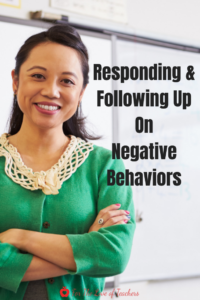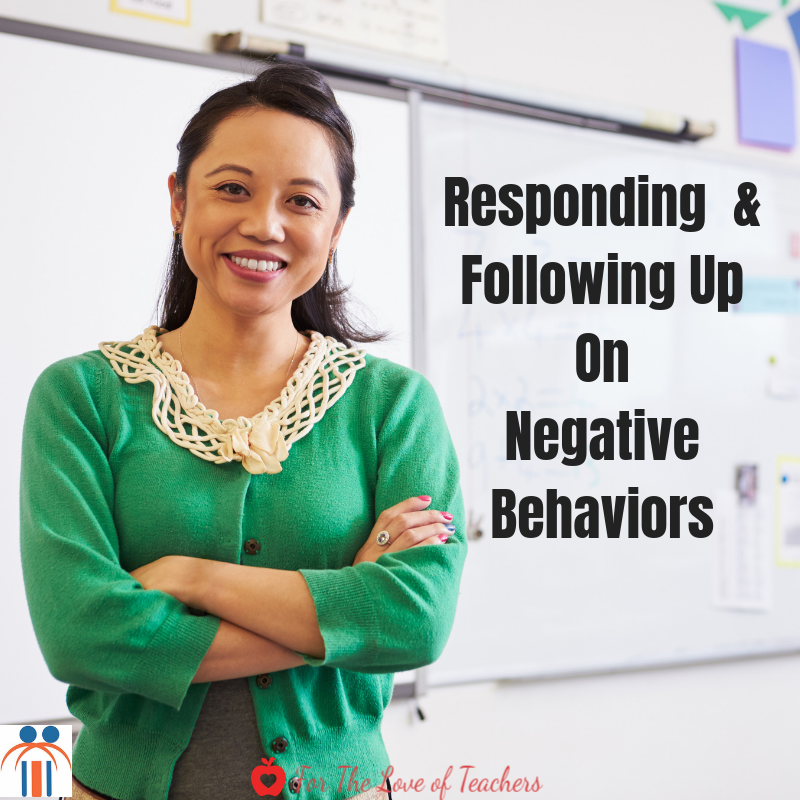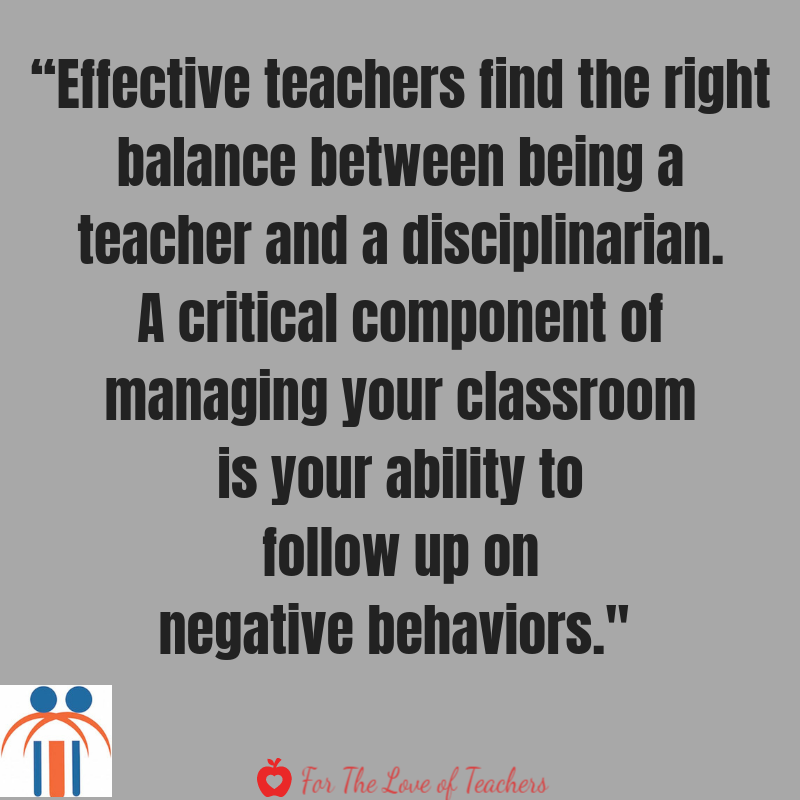So often as teachers or parents we fail to follow up on negative behaviors. Sometimes negative behaviors are ignored or unaddressed because it takes so much time, energy and multiple problem-solving strategies. It’s very time consuming, exhausting and often takes away from daily instruction in the classroom. That’s why we need strategies in place for responding and following up on negative behaviors that are immediate and consistent because once you let negative behaviors go, you’ll see them spreading like wildfires in your classroom, and even at home.
If you read my post, How Positive Feedback Changes Negative Behaviors, I share my personal experience with my own child flexing his muscles and testing boundaries. So many things that I’ve tried, like punishment, empty threats and flexing back my bigger Mom muscles just don’t work. It results in power struggles and more negative behaviors. So I use praise and positive feedback to change those reoccurring negative behaviors into positive ones. But as teachers and parents, we know that it takes a village to raise children these days and we need a BIG bag of strategies. Responsive Classroom’s Logical Consequences works when responding to negative behaviors.
Responsive Classroom’s Logical Consequences are a way of responding to misbehavior that is respectful of children and helps them take responsibility for their actions. Unlike punishment, the primary goal of Logical Consequences is to help children develop inner control by looking closely at their own behavior and learning from their mistakes. Logical Consequences are related, respectful and reasonable. Making reparations gives children the opportunity to face and fix their mistakes.
Three Types of Logical Consequences
-
“You Break, You Fix It”
Examples: This consequence teaches children that they are responsible for “fixing” the problem they caused, whether accidentally or intentionally.
-
If a child breaks another child’s pencil, the child who broke the pencil gives the child their pencil.
-
If a child calls another child a name, the child will make a list of nice things about the person.
-
If a child snaps or yells at another child, the child will do something nice to make them smile.
Apology of Action
Sometimes saying “I am sorry” doesn’t always solve a problem or fix a child’s hurt feelings. If a child calls another child a name, the teacher might suggest to the child who called the name to draw a happy picture for the other, make a list of nice things about that person or include them in a friendly game to make up for the name-calling and hurt feelings. This makes the child responsible for their actions as well as fixing their behavior.
-
Positive Time Out
This consequence is a non-punitive approach for children to manage their behavior and regain control even when the smallest disturbances occur before it escalates.
Example:
If a child disrupts a lesson by calling out, the teacher tells the student to take a time out or a “break” in the designated place. In the time the student is in positive time out, the student practices the techniques that have been modeled and taught and returns to the class activity when he/she has regained control.
-
Loss of Privilege
When the child’s behavior is unexpected or shows defiance or testing of the school or class rules, the consequence is a loss of privilege.
Examples:
-
If a child is using class supplies unsafely or in an inappropriate manner, the child loses the privilege of using class supplies for that time period.
-
If a child is uncooperative or is disruptive during group work, the child loses the privilege of working in the group that day.
-
If a child is not doing their classroom job, the child loses the privilege of having that class job.
Need help with this? Get my Logical Consequences modeling script here. It provides the right language for teaching, modeling and responding to negative behaviors.
Thoughtful Teacher, a classroom management model designed to transform the way teachers manage their students, suggests ways to follow up on negative behaviors. They include, “the teacher’s proximity to students, eye contact, writing the student’s name on the board, and calling the students name.” I can vividly remember my third-grade teacher writing all student names on the board and then choosing one student to stand at the board and place checkmarks next to the name of each student(s) who were on task and behaving well. The teacher rewarded students with how many checks they received at the end of the school day. Now I’m not sure if this was the best strategy but it worked. I remember sitting up straight and tall with my hands folded and completed all my work with my best effort. I wanted LOTS of checkmarks, more than my peers and wanted to be rewarded for my good behavior.
Here are other suggestions from Thoughtful Teacher for following up on negative behaviors:
-
Conference with the student
-
A phone call to parents
-
Email to parents
-
Lunch Detention
-
Behavior contract
-
Mandatory teacher/parent conference
All of these are helpful strategies to respond and to follow up on negative behavior. Whatever you do, don’t ignore them, and always be consistent and immediate with responding and following up on negative behaviors.
How do you respond and follow up on negative behaviors?
What works for you?
Related posts:
Managing Student Behavior Responsive Classroom Style
Redirecting Language: A Tool For Managing Student Behavior
Starting The Year Off Right With Responsive Classroom
If you think that Thoughtful Teacher is for you because you need or want support in classroom management then reach out to your admin about the benefits of Thoughtful Teacher. Don’t be afraid to ask for support or to educate them! For more information visit www.thoughtfulteacher.org. If you have any questions, you can contact info@thoughtfulteacher.org.
Be sure to join the forums to collaborate with other AMAZING teachers! Follow me to be notified when new resources are uploaded to the Shop and join the email list to receive the latest and greatest updates, posts, and monthly freebies!
If you like it, then pin it,



Christine Weis is a passionate educator, classroom management coach, wife, and mom of two busy boys. She enjoys teaching, writing, and creating resources for teachers.






I absolutely agree with the action of apology. That was something our mother made us do growing up, like if we got into a fight with a sibling, we each had to write a full page letter stating why we were personally wrong, what we had done wrong and include an apology and something nice about our sibling. It was sometimes more brutal than an actual punishment!
WOW!! Your mom was on it! 😉 I bet writing an apology sometimes felt worse than actual punishment. An apology of action takes time, thought and sincerity. It really does teach you a lesson. Thanks for reading!
Christine at For The Love of Teachers
I love the idea of accepting responsibility for your actions and fixing something when you break it. It holds the children accountable for themselves.
Yes…accountability is key for children, especially as they grow into adults. Thanks for reading!
Christine at For The Love of Teachers
What works for us is when my sons teacher email me about his behavior. It gives me the details needed to address it properly. It’s so much better than a simple ‘good day – bad day’ report. Without the details I didn’t know how to respond to his behavior and it kept happening.
I agree! When you know the details you can address it immediately and give the appropriate consequence if needed. Thanks for reading!
Christine at For The Love of Teachers
Finding consistency in the consequences for the action is important- sometimes there is no follow through – empty threats will never change behavior
Exactly…empty threats never work, but being consistent does! I’m learning this more and more as a parent! Thanks for reading!
Christine at For The Love of Teachers
Children are a sensitive lot. You have given some really helpful suggestions for a teacher. Sharing with few of my friends.
Thank you! Please do share…appreciate it! Thanks for reading!
Christine at For The Love of Teachers
If I’m around something negative I try to help the other person to get out of that energy. Talk someone down can help that.
Very true…that’s a great strategy! Thanks for reading!
Christine at For The Love of Teachers
I can’t even imagine being a teacher & dealing with all of this… it’s why we have to give so much credit & praise to the people teaching our children!
Thank you Hal! I appreciate that! Being a teacher is not for the weak…lol! That’s my newest line. 😉 Thanks for reading!
Christine at For The Love of Teachers